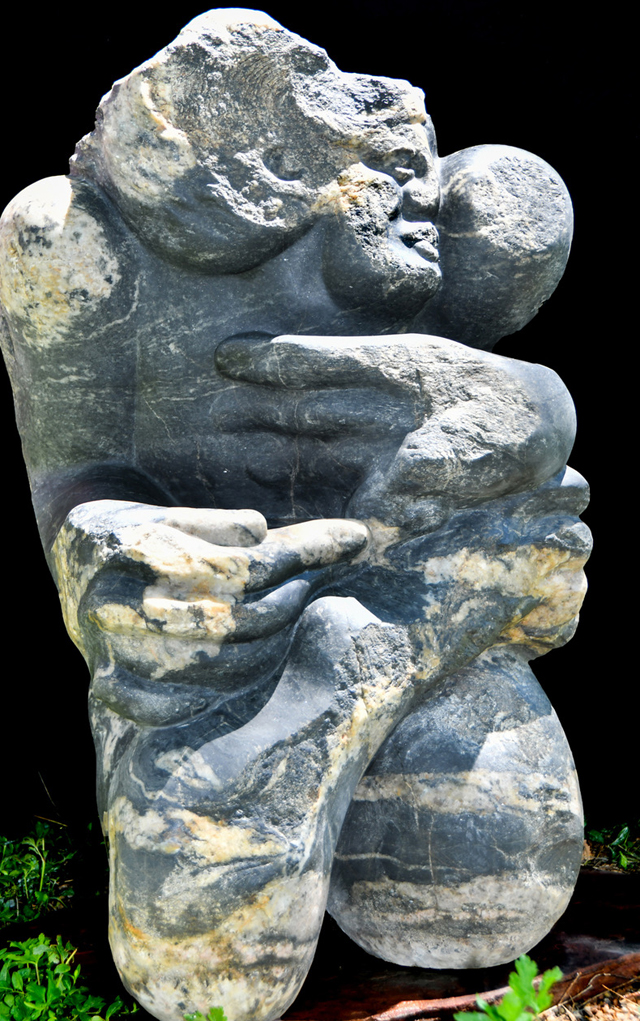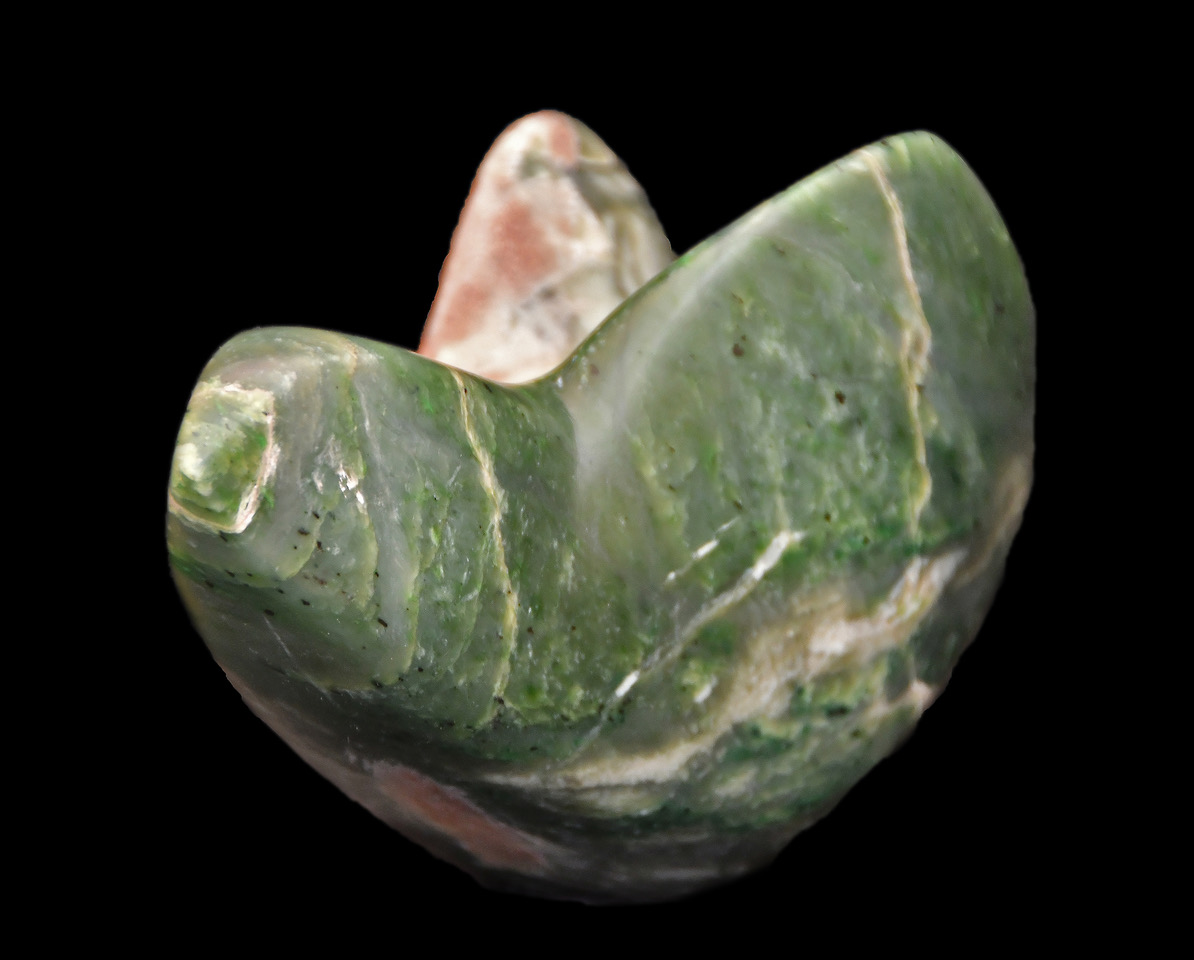
“Good morning, friends,” artist Kimmerjae Macarus says into her iPhone camera. “I’ve been feeling like my sculpture needs to move into something different, so I’m building myself a crucible and tomorrow I’m jumping in — 12 weeks, 12 stones and everyday at noon I will post a two-minute video of what I’m thinking about the work.”
This is video one.
The camera pans away from her face and toward a hefty piece of shimmery, vaguely translucent stone. It’s about the size of a toddler, though considerably heavier. Still, you can imagine cradling it in your arms.
“Here’s the first piece I’m going to approach,” Macarus says. “Calcite from Utah. It’s kind of like starting with dessert first. It’s such a gorgeous stone and I feel really unclear about it.”
The next day’s video shows her straddling the stone, her hands hovering above its surface with a small stick which she positions intuitively at various angles across its cracks and divots.
“OK. Here we go. How to start? I’m questioning if I can make something that isn’t objective, something that isn’t an interpretation of something else that already exists or something else that we’ve seen. Like finding faces in clouds, I want to see what emerges and some being is coming up and it has a fierce power to it, but absolutely free of malice.
“I think one of the first things I’m gonna do is drill some holes in this. Here’s an object that came into space and now space is going to enter it… Where to begin?”
If the artist seems a bit uncomfortable, it’s because she’s in unfamiliar territory, working so quickly on so many small stones. She tends to prefer, and is known for, carving big opuses that take a year or more to complete. Like her work “Flower of Life,” for example, a 6-foot tall face of a woman carved in white Colorado marble, or “The Boat of the Universe,” a smiling piece of glacier granite from Salida, Colorado, hollowed out like a big bowl or a scooping chair, an inviting vessel either way.

It might be unexpected, but it’s easy to imagine the 100 pound, 5-foot-2-inch artist carving such behemoth pieces. It seems natural. There’s an undeniable power about her, even in the way she walks, with a little bit of a cowboy saunter, as if she knows the secret advantage in having to stand on your tip toes to see the top of something.
Macarus has always been an artist, but like most of them, her path was twisted as she figured out a way to make a living and wound up working for 20 years as the singular woman on a landscaping crew. She made less money than them, but she worked hard, harder even, and somewhere in the middle of all that sweat a thought occurred that would forever change her course:
“If I can carve a stone to put it in a wall, then I can carve a stone to carve a stone.”
She “went at” her first piece of marble eagerly and clumsily and under that pressure it split in two. A bit embarrassed, she sat back in her chair and that’s the first time she remembers questioning a stone, asking it aloud what she could do to be better. What happened next is between her and the rock, which now lives in her bathroom as a perfectly smooth marble sink.
Since then she’s had to learn to walk the fine line between being led and leading. Sometimes, she says, the pieces of stone will be assertive, telling her what their features are, where they will be and how big. In those instances her job is to listen and perform, like an assistant, the stone her master.
Other times Macarus has to be the assertive one, like with “Wind Horse,” a 9-foot tall basalt stallion commissioned for a private collection that was so big she had to work on a scaffold, and eventually had to hire a crew to help rough it out.
“They started taking off big chunks and the whole thing was sharp, pieces of rock flying off in chunks, cutting us and eating us up,” she says. “It was terrifying. So one afternoon, when enough was enough, I went to the stone and said, ‘You have to be gentle now. You have to do this for me.’ And she was, she totally yielded.”

But for 12 weeks, with 12 pieces of stone, Macarus wanted to try a different approach. In her video introducing the project she walks around the yard at her home in Lafayette, greeting every stone she sees like they were destined to meet. Her camera appears to be on a treasure hunt, peeking under bushes and into weed-filled corners to focus on rocks that have been sitting long enough to sink a little into the ground. To anyone else they would look like nothing special, but in the background you can hear Macarus’s voice jubilantly calling out a newly discovered piece of jade or limestone.
Now in January, it’s been over a month since she finished the 12-week project, and, sitting down for a cup of hot green tea and fresh baked muffins, comes the time for reflection. Her labradorite ring, the same grayish blue color of her eyes, taps on her tea cup, not nervously, but as if keeping track of a vague sense of time that might otherwise go unkept.
Everything in Macarus’s home has been touched by her hands, built in some way, like a sculpture. Everything surrounding her has a story. The feeling inside the house spills outside, onto the patio filled with tools and pieces of stone and oddly shaped chairs, down the stone pathway she built with her ex-partner and good friends and into her small studio, partly inside, mostly out. Only a little hidden from the sidewalks circling her corner lot, Macarus at work has become a featured staple in her neighborhood.
“As I work outside in the driveway a lot of people will stop by, many ask me to teach them,” she says. “Historically, I have had really bad reactions to that — it just makes me want to cry. I want people to love the work, but instead it feels like they are saying, ‘Give me the tools, give me your stone, show me how to do it.’ It feels like they don’t recognize everything that goes into the work, like they don’t have the time or the bother, they just want to do it, own it.
“But in all my years working with stone I’ve learned that to make art that succeeds in this world, you have to make work that calls people to it. I don’t know how to teach that.”
The two-minute videos in the 12-week project are Macarus’s attempt to change her reaction by giving away her instruction as freely and honestly as possible.
“You want to know how I do this?” she asks. “I think about what I think about. I leave behind a tremendous amount of possibility so that I can go to the studio everyday. Instead of countless other things I could do, I choose to sit with a stone and I get to know it, and it’s not easy, I’m always working through my own resistance. All of those are the big challenges of carving stone.”
The irony of the idea that one can be taught to become an artist is heightened in the presence of stone. One need only watch the smaller framed Macarus labor to move massive chunks of rock to understand the weight of the matter.

“Stone requires the creator to develop the sensibility to see all the way into and around the work,” Macarus says. “It’s like when you are cresting a hill and there is a false summit that evades you. The mass of that mountain is something that you don’t feel or understand. To do that you have to wrangle with your imagination of what’s possible, admit the defeat of your will because the stone will not submit. The hammer and chisel are simply revelation’s tools.”
It seems only fitting to ask a deep and penetrating question of this artist, but the only one to come to mind is glaringly obvious and simple: Why do you work with stone?
“I love rocks,” Macarus says. “And, as far as I can tell, most people do too. I remember as a kid, sitting in a neighbor’s gravel driveway with my legs getting all dirty and looking at each one of [those rocks] — each one — like a treasure, the gravel driveway. That’s what I remember. I think humans just know that there’s something in there. I don’t understand that so much, but I recognize it.”














